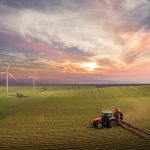As the global population burgeons and urbanization accelerates, the traditional model of agriculture faces unprecedented challenges. The pressure to produce more food on limited arable land while conserving resources and minimizing environmental impact has spurred the rise of innovative solutions. Among these, vertical farming stands out as a beacon of hope, offering a paradigm shift in agricultural production by harnessing the vertical dimension to optimize space utilization. This article delves into the concept of vertical farming, its principles, benefits, challenges, and its potential to revolutionize food production in the face of urbanization and climate change.
Understanding Vertical Farming:
At its core, vertical farming involves the cultivation of crops in vertically stacked layers, often within controlled indoor environments such as warehouses, skyscrapers, or shipping containers. Unlike traditional farming, which relies on horizontal expanses of land, vertical farming leverages advanced technologies such as hydroponics, aeroponics, and aquaponics to grow crops without soil, using nutrient-rich water solutions and artificial lighting. By stacking crops vertically, this approach maximizes space utilization, minimizes water consumption, reduces reliance on pesticides, and enables year-round production, regardless of external climate conditions.
The Advantages of Vertical Farming:
1. Space Efficiency: Vertical farming’s vertical orientation allows for the cultivation of crops in multi-tiered systems, dramatically increasing growing capacity per square meter of floor space. This spatial efficiency is particularly advantageous in densely populated urban areas where land is scarce and expensive.
2. Resource Conservation: By utilizing hydroponic or aeroponic systems, vertical farms can significantly reduce water consumption compared to traditional soil-based agriculture, as water is recirculated and reused within closed-loop systems. Furthermore, vertical farming minimizes the need for chemical fertilizers and pesticides, contributing to environmental sustainability.
3. Climate Resilience: Indoor vertical farms provide a controlled environment where temperature, humidity, and light levels can be optimized for plant growth, regardless of external weather conditions. This climate resilience mitigates the risks associated with climate change-induced extreme weather events and ensures consistent crop yields year-round.
4. Local Food Production: Vertical farms can be established in close proximity to urban centers, reducing food miles and transportation costs associated with conventional farming. This proximity enables the delivery of fresh, nutritious produce to consumers shortly after harvest, enhancing food quality, flavor, and nutritional value.
5. Innovation and Technology: Vertical farming drives innovation in agricultural technology, including automation, robotics, artificial intelligence, and LED lighting. These technological advancements optimize resource efficiency, enhance crop yields, and reduce operational costs, making vertical farming increasingly viable and economically competitive.
Challenges and Considerations:
Despite its promise, vertical farming faces several challenges and considerations that must be addressed to realize its full potential:
1. High Initial Investment: The capital costs associated with setting up vertical farming facilities, including infrastructure, equipment, and technology, can be prohibitive, limiting widespread adoption, particularly in developing countries.
2. Energy Consumption: Indoor vertical farms require significant energy inputs to power artificial lighting, climate control systems, and water circulation pumps. While advancements in energy-efficient LED lighting and renewable energy technologies mitigate this concern, energy consumption remains a consideration for sustainable operation.
3. Crop Selection and Genetics: Not all crops are well-suited to vertical farming due to factors such as growth habits, light requirements, and root structures. Selecting crop varieties optimized for vertical farming systems and conducting research on crop genetics and breeding are essential to maximize yields and profitability.
4. Market Viability and Consumer Acceptance: Vertical farming must demonstrate its economic viability and consumer acceptance to gain traction in the marketplace. Educating consumers about the benefits of vertical farming, addressing perceptions regarding “naturalness” and taste, and ensuring competitive pricing are critical factors for market success.
5. Regulatory and Policy Frameworks: Regulatory frameworks governing food safety, quality standards, land use, and zoning regulations may need to be adapted to accommodate vertical farming practices. Policymakers play a crucial role in creating an enabling environment that supports innovation, investment, and the sustainable growth of vertical farming.
The Future of Vertical Farming:
Despite the challenges, the future of vertical farming appears bright, fueled by ongoing technological advancements, increasing urbanization, and growing demand for sustainable food production solutions. As research and development efforts continue to refine vertical farming techniques, improve crop yields, and reduce costs, the scalability and economic viability of vertical farming are expected to improve. Furthermore, collaborations between industry stakeholders, academia, governments, and nonprofit organizations can accelerate the adoption of vertical farming and address systemic barriers to its implementation.
Conclusion:
Vertical farming represents a bold departure from traditional agriculture, offering a transformative approach to food production that maximizes space utilization, conserves resources, and enhances climate resilience. While challenges remain, the potential benefits of vertical farming in terms of sustainability, food security, and economic development are too significant to ignore. By harnessing innovation, technology, and collaborative partnerships, vertical farming has the power to reshape the future of agriculture, nourishing urban populations and fostering a more resilient, equitable, and sustainable food system for generations to come. As we reach for the sky, vertical farming holds the promise of a greener, more bountiful harvest for humanity.





